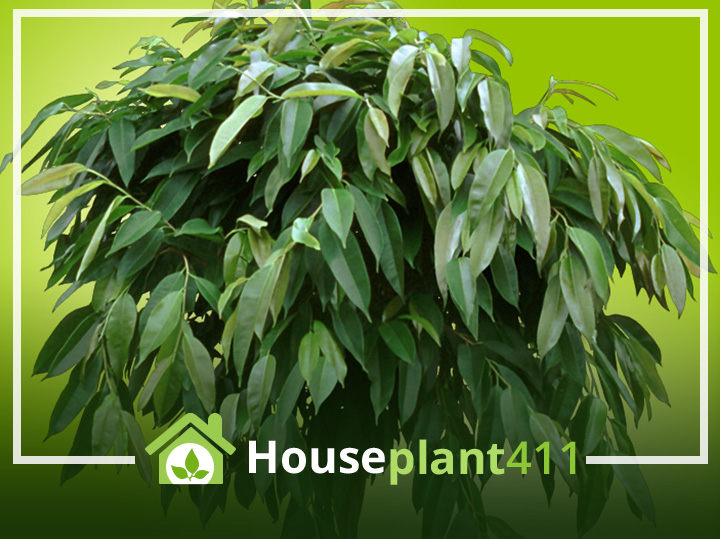The Ficus Alii, or Amstel King as it is sometimes called, is a large plant that originally came from Asia, Malaysia, and India. It was first grown commercially in Hawaii where it got the Hawaiian name “alii” which means “king.” Although a Ficus Alii is closely related to the Ficus Benjamina, the Alii variety is much more tolerant and forgiving; it rarely sheds leaves, tolerates lower light, and can be moved around without going into shock. A ficus Alii does grows about 25% slower than a ficus Benjamina. The leaves are quite different than those of the usual Ficus trees. They are medium green, 3″-10” long, narrow, willow-like, and thick. The newer hybrids such as the King Alii ficus have wider leaves. New growth on the ficus plant is a pretty, reddish-bronze color; but as the leaves mature they change to a medium green. These plants are considered poisonous and should be kept away from pets and children. Read more about common houseplants that are poisonous in Don’t Feed Me to Your Cat: A Guide to Poisonous Houseplants. If you want a ficus tree in your home or office, a Ficus Alii is a great alternative to the finicky Ficus Benjamina
Plant Care
Light
Ficus Alii plants do well in bright, indirect light; however, they can survive in medium light. The lower the light, the longer a ficus Alii takes to produce new leaves. Rotate it weekly to maintain the plant’s beautiful shape.
Water
Water when the top 1″ of the soil has dried out. If the plant is in a container larger than 12″ wait until the top 2″ of soil has dried out. Water deeply so that the excess water drains out the drip holes in the bottom of the pot. Immediately empty excess water and do not allow a ficus Alii to sit in water. New growth turns black and green leaves fall off from over -watering. Leaves become brown and crunchy, drop off, and may turn yellow when the plant needs water.
Fertilizer
Feed monthly with a well-balanced liquid fertilizer when the plant is actively growing. It is not necessary to feed the plant during the winter and fall. Avoid using any plant foods that contain the chemical boron.
Temperature
Unlike the ficus Benjamina, these plants are much more tolerant of temperature changes. Although a ficus Alii prefers temperatures between 60°-85° F (19°-25° C), these plants can survive in temperatures as low as 45°F (7.2°C) for a short time.
Humidity
A ficus Alii prefers medium humidity, but still grows well in basic household humidity.
Flowering
These plants produce Insignificant flowers & berries that should be removed as soon as they appear.
Pests
Pests that attack ficus plants include: mealy bugs, whitefly, scale, and thrip.
Diseases
Gray Mold (Botritis) occurs when the leaves of a ficus Alii are kept too wet. Anthracnose is another plant disease that can be a problem.
Soil
Use a good, all purpose, well- aerated potting soil.
Pot Size
The roots of ficus Alii plants grow very slowly, so don’t be in a rush to move the plant to a larger pot. Be sure the roots have filled the entire bottom of its pot before moving the plant to a larger container. Ficus Alii houseplants like to be root- bound.
Pruning
Prune a ficus during the winter to maintain the shape of the plant and encourage a bushier plant.
Propagation
Propagate a ficus Alli using branch cuttings.
Poisonous Plant Info
Ficus Alii are poisonous plants with a level #2 toxicity. The sap contains latex that can cause skin irritations. Always wear gloves when pruning.
FAQ
You can put your Ficus Alii outside for the summer if it is never in the direct sun and evening temperatures do not go below 55°F (12.8°C).
The side facing the wall is not getting enough light. You need to turn your ficus Alii each week so that all sides are getting sufficient light or it will lose leaves.
The roots of a ficus Alii grow very slowly and the plant likes to be root- bound. Repot about every three years or so when the ficus has become root- bound.
Ficus trees get yellow leaves when they need more water. Green leaves fall off or get brown and crunchy and baby leaves turn black when a ficus is over- watered.

